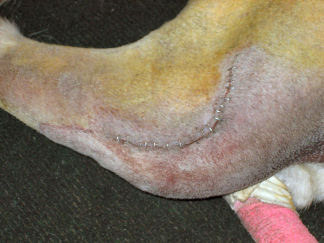The most commonly seen injury in active dogs is a torn ligament in the knee. Dogs have the same bones and ligaments forming their knee joint as people do and they can suffer the same type of injuries. One of these ligaments, the anterior cruciate ligament (ACL) is the structure that is most frequently damaged. This is a common injury in football players, skiers, and other human athletes. Damage to the ligament occurs when the knee is twisted during weight-bearing or when the knee is hyper extended. In sporting dogs, the mechanism of injury is similar and this can occur in the field during strenuous activity. Dogs may also suffer a torn ligament during routine activities such as retrieving. An injured dog may, or may not, cry out at the time of injury. They will usually hold up the affected hind leg. Inability to use the leg is typical of a complete tear of the ligament. A partial ACL injury can also occur. In this chronic condition, the ligament becomes damaged over a prolonged time without a major traumatic event. These dogs tend to experience episodes of lameness that worsens after exercise. The result of traumatic or chronic lagament injury, is instability within the knee joint. This instability results in pain and lameness, with the possibility of arthritis in the future. The longer the unstable knee goes untreated, the more irreversible arthritic changes occurr, and less satisfactory outcomes result from the delay of surgery.
Veterinary examination of a dog with a torn ACL will usually reveal a swollen, painful knee joint. Dogs with chronic knee instability tend to develop scar tissue, which appears as a firm swelling on the inside of the affected knee. It is important for the vet to determine a chronic vs traumatic condition, as often this will determine which type of surgical repair he/she will employ. X-rays are used to support the diagnosis and to document any arthritic changes in the joint. The most reliable means of diagnosing this injury is to move the femur and tibia in a certain way to demonstrate the instability. This movement is called a "drawer sign." When a veterinarian elicits a positive drawer sign, the lower bone of the knee joint (tibia) is moved forward relative to the upper bone (femur). Simply said, the femur slides backwards on the tibia.
When Bailey had her first tear in 2004...it was in February and she was romping around with Bon and Yukon in the snow. It was very icy and they were all enjoying the snow (like huskies do) when I noticed she had her paw up. We checked it out and nothing seemed to be wrong so we though she had just pulled something. A week later we noticed she would stand back from the boys playing and that was not like her and then she started completely holding it off the ground a few days later. Into the vet we went...and she was diagnosed with ACL. This veterinarian had a specialist who came in once a month to do surgeries so we had to wait a whole month yet to get her in. She assured me it was fine so we waited.
Bailey went through the first surgery very well and recoperated nicely. We had a hard time keeping her calm in the house when she knew the boys were outside, running around without her. But all went well and she had a full recovery. We do think she has arthritis already setting in that leg. She has adapted to sitting differently and has to twist around to get up. That is why I think she is having a hard time with getting up now on that leg for all her rear support with this new surgery.
Now onto Bailey's update.
What a week we have had. As I had mentioned they put a patch (Fentanyl) on Bailey that was a slow release patch for the pain. She was whining and howling and whimpering all day and night... practically 24 hours. I called the vet yesterday morning (Friday) and explained her condition and he thought maybe the patch was irritating her because the dog should be pretty much drugged and drowzy. She was aggitated and wide awake. So after much discussion...he finally said to take it off. As the day went on...she became even more aggitated and developed diarrhea...BAD! Her pupils were dialated and she was continueing salivatating. I called to tell them her condition and they said to bring her in. Once there, they gave her a shot of Buprenorphine, checked her over and sent her home. We have been putting her in the landry room as it is the smallest and most confined so she has to pretty much rest and when we brought her home...she went straight in there and laid down and we didn't hear a peep from her...until 10:30 PM. Then she started all back up again. I took her out to do her job...came back in and gave her a Rimadyl and within 20 minutes...she was out!
Today...she seems less energetic but has not shown any of the signs she has been displaying since the surgery. I am so glad as she seems to be in no pain ... or at least to a tolerable level. Below is a close up of her incision and the staples.

1 comment:
My pit bull is having an ACL surgery in a week and have been doing research on it-everything came out okay for you? I am very worried, but I know he needs it.
Post a Comment